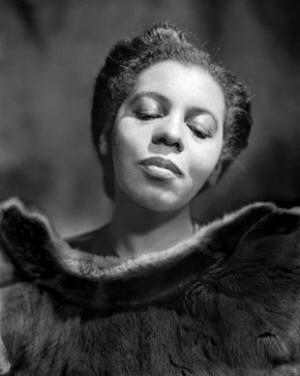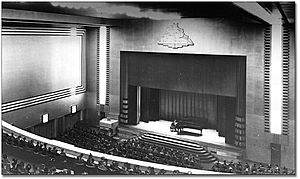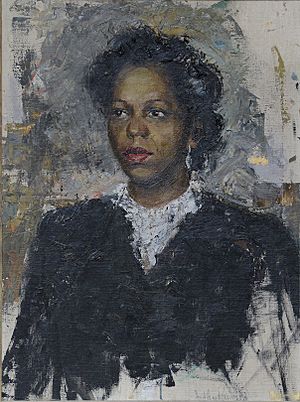Portia White facts for kids
Quick facts for kids
Portia White
|
|
|---|---|

Portrait of White, taken in 1946 by Yousuf Karsh
|
|
| Born | June 24, 1911 Truro, Nova Scotia, Canada
|
| Died | February 13, 1968 (aged 56) Toronto, Ontario, Canada
|
| Occupation | Contralto |
| Years active | 1941–1968 |
| Children |
|
| Family |
|
Portia May White (June 24, 1911 – February 13, 1968) was a famous Canadian singer. She was a contralto, which means she had a deep female singing voice. Portia White became the first Black Canadian concert singer to gain international fame.
She grew up singing in her father's church choir in Halifax, Nova Scotia. As a teenager, she won local singing competitions. Later, she trained at the Halifax Conservatory of Music. In 1941, she made her first national performance. In 1944, she performed for the first time internationally. Critics loved her performances of both classical European music and African-American spirituals. Portia White later toured across Europe, the Caribbean, and Central and South America.
She retired from singing in 1952 due to vocal problems and cancer. White then moved to Toronto and taught music to young Canadian artists. Some of her students included Lorne Greene and Robert Goulet. One of her last big performances was for Queen Elizabeth II and Prince Philip in 1964.
The Government of Canada recognized Portia White as a person of national historic significance. Her early supporters created the Nova Scotia Talent Trust. This trust gives yearly arts scholarships to new and established local artists. The government of Nova Scotia also gives out an annual Portia White Prize. In 2007, she received a lifetime achievement award from the East Coast Music Association.
Contents
Who Was Portia White's Family?

Portia May White was born on June 24, 1911, in Truro, Nova Scotia. She was the third of 13 children. Her parents were Izie Dora White and William Andrew White. Her mother's family were Black Loyalists in Nova Scotia. Her father's parents were former slaves from Virginia. He moved to Canada on his own.
William White went to Acadia University in Nova Scotia. He became the first Black Canadian to earn a Doctorate of Divinity from Acadia. After the First World War, the White family moved to Halifax. William became the minister of the Cornwallis Street Baptist Church.
Many of Portia White's family members became important in Canadian life. Her brother Jack was a well-known labour union leader. Her brother Bill was the first Canadian of African heritage to run for political office. Her nephew was Senator Donald Oliver.
How Did Portia White Start Singing?
Portia White began singing at age six in the Cornwallis Street Baptist Church choir. Her mother was also the music director there. As she got older, Portia became the choir director. She also sang on her father's weekly radio show to help raise money for the church.
White once said that she was "born singing." She felt that if she couldn't talk, she would still communicate through singing. She always dreamed of performing on stage. As a teenager, Portia and her sister June entered a local singing contest. They sang a song from an opera called Lucia di Lammermoor and won first prize. Portia wanted to be a singer, but she could not afford training.
In 1929, White went to Dalhousie University to study teaching. In the early 1930s, she taught in Africville and Lucasville. These were small Halifax communities with mostly Black Nova Scotian residents. During this time, she finally started paying for vocal lessons. She often competed at the Halifax Music Festival. She won the Helen Kennedy Silver Cup in 1935, 1937, and 1938. The festival organizers eventually let her keep the cup permanently.
In 1939, White won a scholarship to the Halifax Conservatory of Music. She studied with Ernesto Vinci, a famous Italian singer. Vinci taught her the bel canto vocal style, which means "beautiful singing." Soon after, White gave her first formal concert. She continued singing on radio shows and in concerts during the Second World War. She won more awards at music festivals. In 1941, she met Edith Read, a school headmistress from Toronto. Read offered to help Portia find new performance opportunities.
Portia White's Singing Career

In November 1941, with Edith Read's help, Portia White made her national debut. She was 30 years old. She sang in Toronto at the Eaton Auditorium. Audiences loved her performance. The day after, she received an offer for career management. Even though she faced racism when trying to book shows, White toured across Canada. She performed at places like the Governor General's Rideau Hall residence.
Portia White sang both classical European music and African-American spirituals. Songs by Harry T. Burleigh were always part of her concerts. She sang in English, Italian, German, French, and Spanish. Her voice had a three-octave range, which means she could sing very high and very low notes. Critics praised her voice. One critic said she had a "beautifully shaded contralto... It is a natural voice, a gift from heaven." People even compared her to the famous American contralto Marian Anderson.
After an audition for Metropolitan Opera manager Edward Johnson, White made her international debut. This was in New York City in 1944. She was the first Canadian to perform at New York's Town Hall. New York Times called her performance "remarkable." Another critic wrote that White had a "magnificent vocal instrument."
White performed many more concerts across the United States. The province of Nova Scotia and the city of Halifax gave her financial support. They even bought her a white fox cape to wear during performances. In 1945, she signed a contract with Columbia Concerts Incorporated. In 1946, she went on a three-month tour of Central and South America and the Caribbean. In 1948, she sang in France and Switzerland. Portia White was the first Black Canadian concert singer to become internationally famous.
Vocal problems, a very busy schedule, and a breast cancer diagnosis led to White's early retirement. She stopped public singing in 1952. She settled in Toronto and studied with famous sopranos Gina Cigna and Irene Jessner. She also taught music at the Royal Conservatory of Music. White taught some of Canada's rising musical stars. Her students included singers Lorne Greene, Dinah Christie, Don Francks, Robert Goulet, and Anne Marie Moss.
White performed a few times in Halifax during the 1950s. She said she wanted to sing full-time again, but it never fully happened. In 1964, she sang for Queen Elizabeth II and Prince Philip. This was at the opening of the Confederation Centre of the Arts in Charlottetown, Prince Edward Island. It was one of her last major concerts.
Portia White passed away in Toronto on February 13, 1968, at age 56.
Portia White's Legacy and Honours
In 1944, Portia White's supporters in Nova Scotia created the Nova Scotia Talent Trust. This trust helped her financially with her singing career. The Trust now gives yearly scholarships to other artists from Nova Scotia. They also give the Portia White Award to artists who show "exceptional commitment and potential in voice."
The Nova Scotia government also gives a Portia White Prize for "cultural and artistic excellence." In 1998, the first Portia White Prize went to Nova Scotian poet George Elliott Clarke. He is Portia White's great-nephew.
The Government of Canada has declared White a person of national historic significance. She was featured on special Millennium postage stamps celebrating Canadian achievements. In 2007, she received a Dr. Helen Creighton Lifetime Achievement Award at the East Coast Music Awards. A street in Halifax, Portia White Court, is named after her. The Portia White Atrium in Citadel High School is also named in her honour. In 2017, the Portia White Youth Award was created as part of the African Nova Scotian Music Awards.
Portia White has been the subject of a play by Lance Woolaver called Portia White: First You Dream. Sylvia Hamilton made a documentary about her called Portia White: Think on Me. George Elliott Clarke also wrote a book about her.
A painting of White by Hedley Rainnie is always on display at Government House, Nova Scotia. This honours her important contributions to the arts.
What Music Did Portia White Record?
- Think on Me (1968, White House Records) WH-6901
- Great Voices of Canada, Vol 5. White et al. Analekta AN 2 7806
- First You Dream (1999. C. White) W001-2
- Library and Archives Canada also has recordings of White's live performances.
See also
 In Spanish: Portia White para niños
In Spanish: Portia White para niños
- Black Nova Scotians
- Music of Canada



